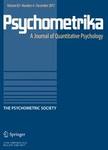版权所有:内蒙古大学图书馆 技术提供:维普资讯• 智图
内蒙古自治区呼和浩特市赛罕区大学西街235号 邮编: 010021

作者机构:Osaka Univ Suita Osaka 5650871 Japan
出 版 物:《PSYCHOMETRIKA》 (心理测量学)
年 卷 期:2013年第78卷第2期
页 面:380-394页
核心收录:
学科分类:0402[教育学-心理学(可授教育学、理学学位)] 04[教育学] 0701[理学-数学]
基 金:Japan Society for the Promotion of Science [(C)-23500347] Grants-in-Aid for Scientific Research Funding Source: KAKEN
主 题:factor analysis EM algorithm improper solutions maximum likelihood method
摘 要:Rubin and Thayer (Psychometrika, 47:69-76, 1982) proposed the EM algorithm for exploratory and confirmatory maximum likelihood factor analysis. In this paper, we prove the following fact: the EM algorithm always gives a proper solution with positive unique variances and factor correlations with absolute values that do not exceed one, when the covariance matrix to be analyzed and the initial matrices including unique variances and inter-factor correlations are positive definite. We further numerically demonstrate that the EM algorithm yields proper solutions for the data which lead the prevailing gradient algorithms for factor analysis to produce improper solutions. The numerical studies also show that, in real computations with limited numerical precision, Rubin and Thayer s (Psychometrika, 47:69-76, 1982) original formulas for confirmatory factor analysis can make factor correlation matrices asymmetric, so that the EM algorithm fails to converge. However, this problem can be overcome by using an EM algorithm in which the original formulas are replaced by those guaranteeing the symmetry of factor correlation matrices, or by formulas used to prove the above fact.